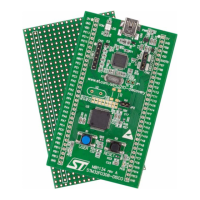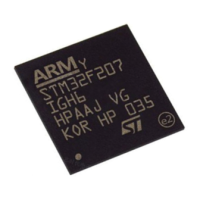RM0008 USB on-the-go full-speed (OTG_FS)
Doc ID 13902 Rev 12 803/1096
28.2 OTG_FS main features
The main features can be divided into three categories: general, host-mode and device-
mode features.
28.2.1 General features
The OTG_FS interface general features are the following:
● It is USB-IF certified to the Universal Serial Bus Specification Rev 2.0
● It includes full support (PHY) for the optional On-The-Go (OTG) protocol detailed in the
On-The-Go Supplement Rev 1.3 specification
– Integrated support for A-B Device Identification (ID line)
– Integrated support for host Negotiation Protocol (HNP) and Session Request
Protocol (SRP)
– It allows host to turn V
BUS
off to conserve battery power in OTG applications
– It supports OTG monitoring of V
BUS
levels with internal comparators
– It supports dynamic host-peripheral switch of role
● It is software-configurable to operate as:
– SRP capable USB FS Peripheral (B-device)
– SRP capable USB FS/LS host (A-device)
– USB On-The-Go Full-Speed Dual Role device
● It supports FS SOF and LS Keep-alives with
– SOF pulse PAD connectivity
– SOF pulse internal connection to timer2 (TIM2)
– Configurable framing period
– Configurable end of frame interrupt
● It includes power saving features such as system stop during USB Suspend, switch-off
of clock domains internal to the digital core, PHY and DFIFO power management
● It features a dedicated RAM of 1.25 Kbytes with advanced FIFO control:
– Configurable partitioning of RAM space into different FIFOs for flexible and
efficient use of RAM
– Each FIFO can hold multiple packets
– Dynamic memory allocation
– Configurable FIFO sizes that are not powers of 2 to allow the use of contiguous
memory locations
● It guarantees max USB bandwidth for up to one frame (1ms) withouth system
intervention

